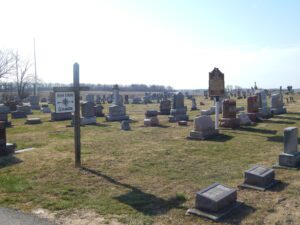, OH
The Methodist Episcopal Church pioneered organized religion in Perkins Township in 1811, then in Sandusky when the Rev. Alfred Brunson preached the city’s first sermon in January, 1818. In 1829 the Methodists built Sandusky’s first church, on West Square, and had later churches on the present sites of the Court House and Post Office. This building was begun in 1922, the sanctuary completed in 1958. The Perkins and Sandusky congregations united in 1930.
, OH
Betsey Mix Cowles dedicated her life to fighting slavery and improving the status of women. Her desire for a formal education led her to Oberlin College, where she completed two years of study in 1840. An advocate of immediate abolition, Cowles lectured on the moral depravity of slavery, opened her home, at this site, to fugitive slaves. Opposed to expansion of slavery into the West, Cowles protested the Mexican War. Cowles served as president of Ohio’s first women’s rights convention (in Salem) in 1850, and the following year wrote a treatise on equal pay for working urban women. She served as the first dean of women at Grand River Institute, and later became one of the first women public school superintendents in Ohio.
, OH
A Shaker village called Watervliet, Ohio, was located here from 1806-1900. The Shakers, originally called the United Society of Believers in Christ’s Second Appearing, were followers of Mother Ann Lee who came from Manchester, England in 1774 and established the first Shaker community in Watervliet, New York. The tenets of the religion included communal living, celibacy, and public confession of sins. The frenzied dance movements, which were part of the worship of their sect, gave the members the name “Shakers.” Attracted by the great Kentucky revivals in the late 1700s and early 1800s, Eastern Shaker missionaries came west to find converts and establish communities. A discontented Presbyterian congregation in the Beaver Creek area called Beulah was the nucleus for the Watervliet Shaker community. (continued on other side)
, OH
One of the most influential Native Americans of the 19th century, Tecumseh was born in 1768 in the Pickaway settlements on the Mad River and raised by older siblings at Old Town. A prominent Shawnee war leader who vigorously opposed American expansion, he fought at the Battle of Fallen Timbers but refused to attend the subsequent signing of the Treaty of Greene Ville in 1795. Angered by purchases of Native American land in Indiana by the United States, Tecumseh promoted a pan-Indian confederacy to resist the encroachment of white settlers, traveling thousands of miles throughout the western and southern frontiers in an effort to gain supporters for the alliance. Tecumseh sided with the British during the War of 1812 and was killed at the Battle of the Thames on October 5, 1813. His death ended hopes for a united Indian coalition.
, OH
The Jain Center of Central Ohio was established on May 12, 1991. The foundation stone of the Jain temple, the first of its kind in Central Ohio, was laid down on October 15-16, 2011. The temple was dedicated on July 19-23, 2012. More than 1,000 people from all across Ohio, many other states and India particpated in holy rituals to install deities of Jina (translated as “spirital victors” and God). Following the rituals, the temple was opened for regular worship. The Jain Center is a place for the teaching on non-violence, reverence for life and compassion for all beings. The Jain principle of karma states, “As you sow, so shall you reap.”
, OH
Phoebe Ann Mosey, also known as Annie Oakley, was born six miles northeast of here in what was then Woodland, later renamed Willowdell. Born in 1860, she was the sixth daughter born to Jacob and Susan Mosey. After the death of her father, she engaged in shooting wild game to feed the Mosey family. This child prodigy shooter shot match after match until she won a life-changing match in 1881 with champion shooter, Frank Butler. In 1882, Phoebe Ann married Butler in Windsor, Ontario.
, OH
Utopia was founded in 1844 by followers of French philosopher Charles Fourier (1772-1837). Fourierism, based on utopian socialism and the idea of equal sharing of investments in money and labor, reached peak popularity in the United States about 1824 until 1846. The experimental community of Utopia dissolved in 1846 due to lack of financial success and disenchantment with Fourierism. John O. Wattles, leader of a society of spiritualists, purchased the land and brought his followers to Utopia in 1847. The spiritualists, who sought secluded areas to practice their religion, built a two-story brick house on the shore of the Ohio River. A flash flood on December 13, 1847, killed most of Wattles’ people. The majority of the few survivors left the area. Thus, the idea of the perfect society, or utopia, died. Henry Jernegan of Amelia, laid out the present village in 1847.
, OH
Named for the 1903 co-inventors of the airplane, Wilbur and Orville Wright of Dayton, Ohio, Wright Field has been the center of aeronautical research, development, and weapon system acquisition since its establishment. Wright Field assumed this mission and was dedicated on October 12, 1927 after McCook Field (1917-1927), America’s “Cradle of Aviation” near downtown Dayton, closed its gates. ?Here on this ground where Wilbur and Orville Wright brought to full life man’s age-old dream of rising in flight above the earth, we of Wright Field consecrate ourselves to the splendid vision and unswerving purpose which motivated those great and honored pioneers of the sky. Their patience, their firm determination, their untiring devotion to their aim ” these we take as a light to guide and inspire us.” –Creed of Wright Field, December 17, 1942









